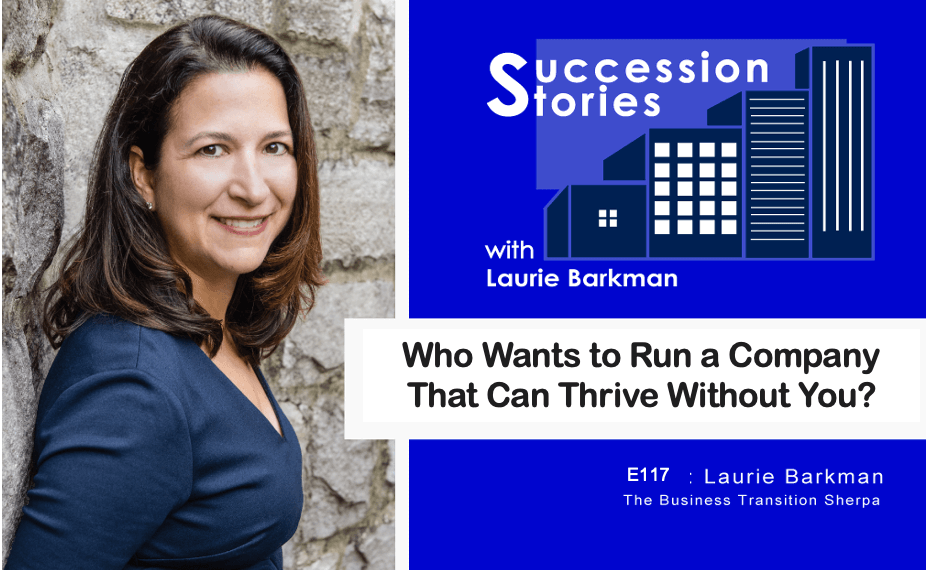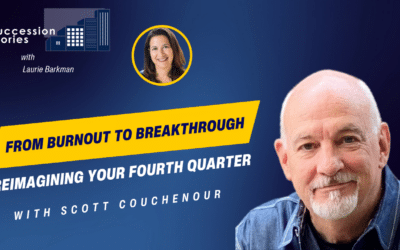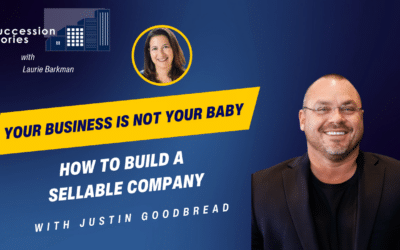Solocast with Laurie Barkman, show host and business transition sherpa. In this solocast, Laurie talks about her new book, “The Business Transition Handbook,” and discusses a critical owner succession pitfall to avoid – your company needs you too much. A business that relies too heavily on the skills or relationships of the owner is a less transferable and valuable business. Laurie dives into seven ways you can reduce or eliminate value-crushing dependencies by minimizing value derailers and preparing for future ownership succession. Regardless of when you intend to exit, you will benefit by following these time-tested best practices to create a more profitable and enjoyable business to run today.
Show Links:
- Complete a Value Builder Business Assessment at MyTransitionScore.com
- Order “The Business Transition Handbook” on Amazon https://amzn.to/3Hqj2eo
- Get a free Business Transition Toolkit. Download secrets to a successful exit. thebusinesstransitionhandbook.com
- Download 4 Degrees of Delegation eBook: https://bit.ly/4DegreesDelegation
- Subscribe to Succession Stories YouTube Channel
- Connect with Laurie Barkman on LinkedIn: https://www.linkedin.com/in/lauriebarkman/
About Succession Stories Podcast
Succession Stories is an award-winning podcast guiding entrepreneurs from transition to transaction. Hosted by Laurie Barkman, author of “The Business Transition Handbook: How to Avoid Transition Pitfalls and Create Valuable Exit Options.”
Get your copy at: www.theBusinessTransitionHandbook.com
Start your business transition plan by visiting: https://thebusinesstransitionsherpa.com
______________________________
SHOW SPONSOR: STONY HILL ADVISORS
Stony Hill Advisors works with owners like you to get ready and maximize value when you’re ready to sell.
Visit www.stonyhilladvisors.com/podcast for a complimentary business valuation.
Transcript:
In this solocast, I’m going to cover a critical owner succession pitfall to avoid – your company needs you too much.
This topic is covered in my book, The Business Transition Handbook: How to Avoid Succession Pitfalls and Create Valuable Exit Options.
It’s the number one pitfall to be aware of – does your organization need you too much? And what can you do about it?
Data from The Value Builder System shows that companies with equity holders who are personally responsible for more than 25 percent of the company’s revenue are half as likely to receive an offer, and you’re more likely to see a discount on the company’s value.
When the business relies too heavily on the skills or relationships of the owner, there’s a negative effect on value because there’s a risk that the company won’t thrive into the future without the owner.
In exit planning, and getting your company ready for succession or sale, transferability is an important concept.
If only one person in your business leads mission critical functions, it could pose risk to your business today, and to a new owner in the future.
When was the last time you took a vacation? Did you truly unplug or frequently check messages? Did your people handle things swimmingly while you were gone, or were there fires the size of a Hawaiian volcano?
Here are 7 ways to make your organization less dependent on you:
1- Identify risks to business value
It’s important to check in where your business is today. Don’t put your head in the sand about value crushing risks that are within your control. Take the Value Builder online business assessment at mytransitionscore.com and discover potential risks and solutions to improve value.
The co-founder and CEO of a graphic design company was surprised by the results of her Value Builder assessment. She said, “You helped me see that I’m holding my company back. I used to think me being one of the main reasons customers work with us was invaluable. Now I understand the fatal flaw in my thinking.”
This was a pivotal moment…to see your business in a new way. The link for the business assessment is in the show notes if you want to check it out later.
2- Don’t be the Rainmaker
Let’s talk about Rainmakers. Business owners who are “rainmakers” drive more than 25% of total revenue. They drive growth.
Rainmaker owners tend to have strong connections because they are involved in every facet of the customer relationship. They are responsible for service delivery, product development, sales, or maybe even client service. That’s a lot for one person to handle…is it sustainable?
While these relationships can fuel growth initially, over time it will present risk to your business value.
Relationship based deals may be verbal agreements rather than papered. Revenue growth will flatline because there are only so many hours in a day, and there may be limits to one person’s personal capacity to sell.
Not to mention, there’s risk in the business if something happens to your capacity to work in the business.
3- Architect your sales and marketing
Another type of sales and marketing leader is the Architect. The Architect develops a framework that others execute.
This will increase the organization’s sales and marketing capabilities over time. This can mean outsourcing your marketing to an agency. Or hiring people to help you build your marketing processes and systems.
It’s possible to make a switch from a “rainmaker” to an “architect” owner if you can Delegate, Train, and Build:
- Delegate: Delegate responsibilities that are outside of your skillset or sap the lifeblood from you.
- Train: Hire and train salespeople to do the selling. Training others will expand growth opportunities and enable you to focus on other aspects of the business.
- Build: Create processes and systems so that others can do the selling and marketing.
4- Do what you love, outsource the rest
Author Nick Leighton wrote, “Time is a commodity for most entrepreneurs, and the best way to treat it as such is by letting go and outsourcing the work that you don’t love doing—or work that’s beneath your pay grade. At the end of the day, delegating tasks that you don’t enjoy doing can impact your business’s success. Business owners tend to do everything, which isn’t practical as you grow. As the business becomes dependent on you, you focus on your passion less and less. You’re bogged down with processes and this leads to burnout and prevents your business from growing. Instead, do what you love, outsource the rest.”
Delegation is a critical skill for any business owner. If you are personally overseeing the details, chances are you are a bottleneck to your company’s growth and its value. If your goal is to build a business that can thrive without you, you’ll want to master the art of delegation.
Think about the degree of autonomy you want your employees to have. Outline a time-based or financial budget to work within. Encourage employees who get stuck to come to you with questions you can simply answer yes or no. Over time, the number of problems boomerang back to you will diminish.
Another tool is the Skill/Fun Box. Make 4-boxes. Across the top, things you’re good at, not good at. Across the vertical axis, the boxes are things you enjoy, don’t enjoy. Next, think about how you’re spending your time. Are you spending the majority of your time on things that you’re good at but sap your energy? Bring your mood elevator way down. Or are you working on things that bring you enjoyment?
Think also about how you spend your time and if you’re generating value in your business by doing these activities.
For more ways to develop your approach to delegation, I have a great resource for you – an ebook called the 4-Degrees of Delegation. I’ll include the link in the show notes so you can get it.
5- Recognize potential and align incentives
Meredith Meyer Grelli is the co-founder of the Wigle Whiskey Distillery, a hospitality and manufacturing business. For a long time, she recognized that the level of detail at which she was operating was not good for the business. She needed to figure out how to extricate herself. The first step was pre-pandemic, they started developing growth plans for leaders taking a two to three-year view. Once the COVID-19 pandemic hit, everything accelerated. When their hospitality operations shut down they did not lay off staff and the owners became much more active in leadership development, feedback, and actively managing people’s growth plans. They attached financial incentives to the growth of each individual leader. Everyone met the growth targets. The business ran better than when Meredith was trying to micromanage everything. Everyone, including all the team members, and her family, were much happier. Meredith had taken herself out of the day-to-day business, enabling her to become adjunct faculty at Carnegie Mellon University, something she wanted to do. Within a few years, Wigle Whiskey was successfully sold to a strategic buyer.
6- Weigh short-term profits vs long-term value
Some people use profitability and value interchangeably. But they can be in conflict with one another.
Instead of hiring salespeople, the owner seeking to maximize profits would do all the selling themselves. Instead of hiring a management team, they would hire the lowest paid staff they can find to simply execute. While the profit-seeker may maximize their profits, they would also grow a business that may not be sellable.
Kevin Trout started Grandview Medical Resources with the intent to sell one day. The medical equipment company grew at an impressive rate of 30 percent year over year. But this pace created financial risk in the business and was impacting Kevin’s health. He knew he was the bottleneck to growth and had to do something different. He brought in professional managers– vice presidents of operations, finance, and administration. Kevin still ran the sales team, but no longer sold to clients directly. He was only involved in the big deals.
This was a calculated risk because the company couldn’t afford the people at the time, but his investment paid off. Eventually the company grew to $15 million in revenue. His leadership team had day-to-day responsibility, and he held them accountable for the profitability. Kevin put in thirty hours a week and achieved a healthier work life balance. Profits were strong, and he was able to work on the business (not in it). Eventually Kevin sold the company to a strategic buyer. A critical decision was to build the management team around him. Although this decreased short-term profits, the business was more transferable and increased his enterprise value.
Timing is important because just like driving a stick shift, if you push the clutch too soon, you stall the engine. You’re spending too much money. If you hesitate to push in the clutch, you have to avoid people getting burned out.
The number one person that risks getting burned out is you—the business owner. What will your business be worth then?
7 – Test your ability to separate
What if you weren’t in your business for three months?
You can be intentional and purposeful to work on this over time. Take a day off and truly unplug.
Then in six months, take two days off. You’ll know where the gaps are. Maybe you need to delegate some duties to others. Maybe you need to transition responsibilities and document processes. Eventually you may be able to step away from the business to make sure that the business will be okay and thrive without you.
Ok, let’s wrap up…
Here are the things I want you to take away from this solocast:
- Transferability, or the ability for a business to continue operating without the presence of its owner, is important in planning for succession or sale.
- A business that relies too heavily on the skills or relationships of its owner may pose a transition risk to the business and its value.
- Steps that business owners can take to decrease organizational dependency on themselves include expanding leadership teams, cross-training, and increasing the skills of management teams, delegation, and standardizing practices.
How can you make this content actionable?
Decide on three things that you will do within the next three to six months to make your business less dependent upon you. Write them down. You’re more likely to complete them if you write them down.
As a way to stay accountable to your business transition commitments, get a copy of my book. You’ll find more exit value planning tips, stories, and exercises to build value and reduce risk.
The great news is this work will help you run a more enjoyable business today, and increase business value in the future.
If you would like to dive into my book, The Business Transition Handbook, order your copy on Amazon. I’d be honored if you wrote a product review!!
Download the secrets to a successful business transition by visiting TheBusinessTransitionHandbook.com
Make sure to follow Succession Stories to get the newest episodes!
Thanks again, and cheers to your future succession!
















